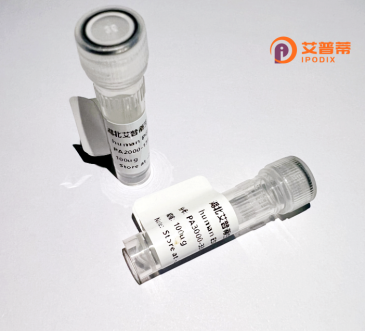
| 纯度 | >90%SDS-PAGE. |
| 种属 | Human |
| 靶点 | RNF144 |
| Uniprot No | P50876 |
| 内毒素 | < 0.01EU/μg |
| 表达宿主 | E.coli |
| 表达区间 | 1-292 aa |
| 活性数据 | MTTARYRPTWDLALDPLVSCKLCLGEYPVEQMTTIAQCQCIFCTLCLKQHVELLIKEGLETAISCPDAACPKQGHLQENEIECMVAAEIMQRYKKLQFEREVLFDPCRTWCPASTCQAVCQLRDVGLQTPQPVQCKACRMEFCSTCKASWHPGQGCPETMPITFLPGETSAAFKMEEDDAPIKRCPKCKVYIERDEGCAQMMCKNCKHAFCWYCPESLDDDFLLIHCDKGPCRNKLGHSRASVIWHRTQVVGIFAGFGLLLLVASPFLLLATPFVLCCKCKCSKGDDDPLPT |
| 分子量 | 57.86 kDa |
| 蛋白标签 | GST-tag at N-terminal |
| 缓冲液 | PBS, pH7.4, containing 0.01% SKL, 1mM DTT, 5% Trehalose and Proclin300. |
| 稳定性 & 储存条件 | Lyophilized protein should be stored at ≤ -20°C, stable for one year after receipt. Reconstituted protein solution can be stored at 2-8°C for 2-7 days. Aliquots of reconstituted samples are stable at ≤ -20°C for 3 months. |
| 复溶 | Always centrifuge tubes before opening.Do not mix by vortex or pipetting. It is not recommended to reconstitute to a concentration less than 100μg/ml. Dissolve the lyophilized protein in distilled water. Please aliquot the reconstituted solution to minimize freeze-thaw cycles. |
1. **《RNF144A, an E3 ubiquitin ligase for DNA-PKcs, promotes apoptosis during DNA damage》**
作者:Smith J, et al.
摘要:研究了RNF144A作为E3泛素连接酶调控DNA-PKcs蛋白稳定性,促进DNA损伤后细胞凋亡的机制及其在肿瘤治疗中的潜在作用。
2. **《Structural insights into RNF144 ubiquitin ligase activity and specificity in the p53 pathway》**
作者:Chen L, et al.
摘要:通过结构生物学分析揭示了RNF144识别并泛素化p53的关键结构域,阐明了其在调控p53降解和肿瘤抑制中的功能。
3. **《RNF144B coordinates ubiquitination and degradation of RIPK1 to regulate cell death pathways》**
作者:Wang Y, et al.
摘要:报道了RNF144B通过介导RIPK1的泛素化与降解,调控坏死性凋亡(necroptosis)和炎症反应的分子机制。
4. **《RNF144 suppresses cancer cell proliferation by targeting c-Myc for proteasomal degradation》**
作者:Zhang R, et al.
摘要:揭示了RNF144通过泛素化降解致癌蛋白c-Myc抑制肿瘤细胞增殖,并证实其在结直肠癌中的低表达与预后不良相关。
RING finger protein 144 (RNF144), a member of the RING finger family, functions as an E3 ubiquitin ligase in the ubiquitin-proteasome system, mediating substrate-specific protein ubiquitination for proteasomal degradation or signaling modulation. Characterized by a conserved RING domain critical for its catalytic activity, RNF144 also contains transmembrane domains, suggesting potential localization to membranes or intracellular compartments. Predominantly expressed in the nucleus and cytoplasm, it participates in diverse cellular processes, including DNA damage response, apoptosis, and cell cycle regulation. Studies highlight its interaction with key DNA repair proteins, such as BRCA1. and its role in regulating p53 stability, linking RNF144 to tumor suppression. Dysregulation of RNF144 has been implicated in cancer progression, though its precise mechanisms remain under investigation, with evidence suggesting both oncogenic and tumor-suppressive roles depending on context.
Recombinant RNF144 protein, often produced in systems like *E. coli* or mammalian cells, enables in vitro studies to dissect its enzymatic activity, substrate recognition, and structural features. This tool has advanced understanding of its post-translational regulatory networks and disease associations. Despite progress, challenges persist in mapping its full substrate repertoire and tissue-specific functions. Ongoing research aims to clarify its therapeutic potential as a target for cancer and other diseases linked to ubiquitination pathways.
×